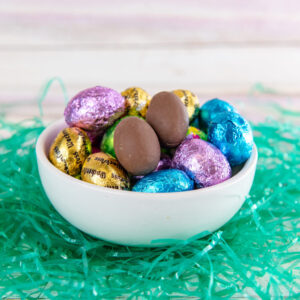
What is the history of Easter candy like chocolate eggs? Read on to find out!
Easter candy is a delicious, beloved treat enjoyed by young and old on this holiday, but when did it become a tradition to enjoy sweet jelly beans, chocolate bunnies, or chocolate eggs on Easter? If you want to impress your loved ones with Easter candy history this year, read on to learn more about the origins of your favorite sweets. Be sure to visit Wockenfuss Candies this season to explore our modern varieties of these classic favorites.
Why Do We Enjoy Candy on Easter?
The Easter bunny who delivers baskets of treats has been a symbol of Easter since about the 1700s. Brought to America by German immigrants, the rabbit symbolizes new life, tying in with this spring season when the natural world wakes up after winter. It also metaphorically echoes in the origins of the Christian holiday, which celebrates the Resurrection of Jesus.
The Easter bunny originally brought colorful eggs, but soon that tradition included chocolate and other small gifts. Sometimes children would leave out carrots for the Easter bunny! American children started building nests out of leaves and sticks in their garden to be filled by the Easter Bunny. This moved the tradition outside and later became the Easter Egg Hunt. However, Easter baskets continue the tradition of filling a “nest” with goodies, leading to the tradition of receiving more than just chocolate eggs.
But why do people indulge in so many sweets on Easter? Part of this tradition may come from the end of the Lenten season on Easter. Many people swear off indulgent foods during Lent, which makes their Easter candy that much more appealing.
Chocolate Eggs
German immigrants originated the edible Easter egg, which was first made of sugar and pastry in the 1800s. Eggs symbolize new life and good luck, very suitable for this holiday. By the late 1800s, U.S. candy makers were offering both hollow and filled chocolate eggs and eggs of unique flavors.
Chocolate Bunnies
Chocolate bunnies are the most popular molded chocolate designs for Easter and the first molded design created for the holiday. They were handcrafted in the 1830s and 1840s and became more commonplace in the 1880s. Over time, innovations in the chocolate industry (such as molding machinery) have made producing this Easter candy much easier. You can now find chocolate bunnies in solid and hollow varieties and in milk or dark chocolate versions.
Jelly Beans
Jelly beans are a candy descendant of the traditional “Turkish Delight.” Jelly beans have only been around since the 1890s, but they quickly became associated with Easter due to their vibrant colors and egg-like shape. This Easter candy is ideal for the season, but the wide range of flavor variety means you can find jelly beans to enjoy year-round.
A Wide Selection of Delicious Treats from Wockenfuss Candies
Head to WockenfussCandies.com and browse our wide selection of chocolates and candies; we promise you won’t be disappointed! Wockenfuss Candies is one of the oldest candy makers in Baltimore. We opened our doors in 1915 and have proudly served the people of Baltimore ever since. If you have any questions about our wide selection of chocolates, please contact Wockenfuss Candies by calling 1-800-296-4414 or email info@Wockenfusscandies.com. When you’re not savoring our sweets, stay satisfied by following us on Facebook, Twitter, and Pinterest!
